
| (1) |

|
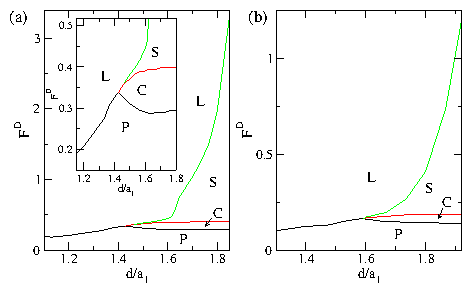
|
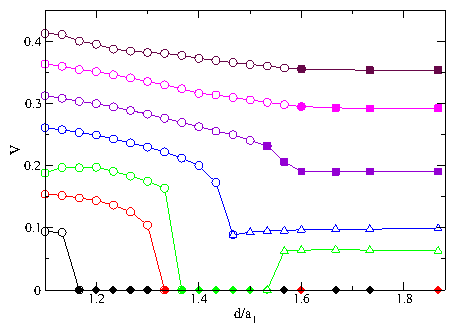
|
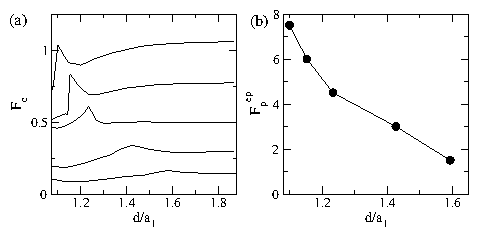
|
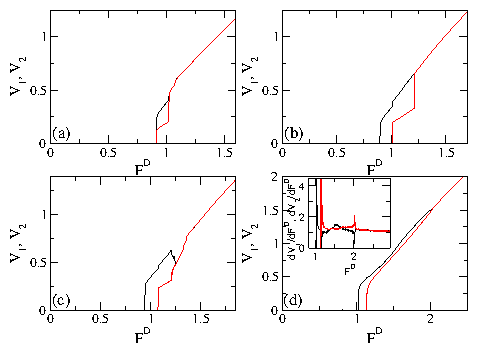
|
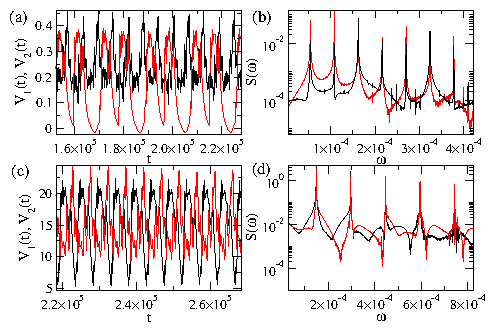
|
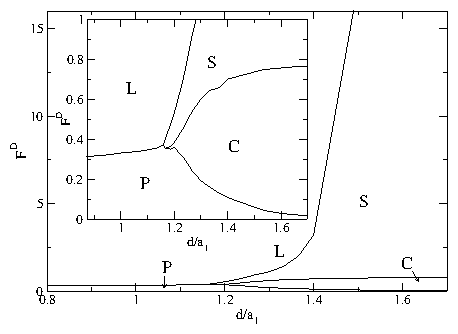
|
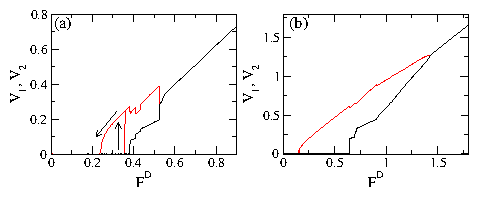
|
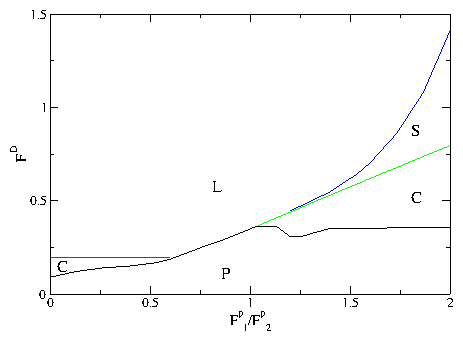
|
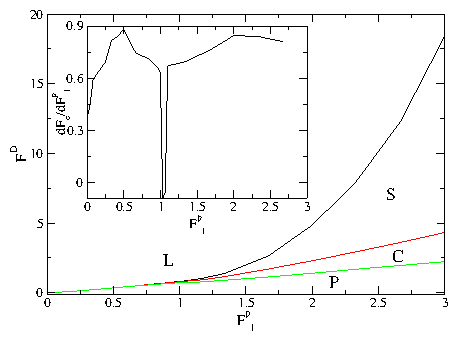
|

|
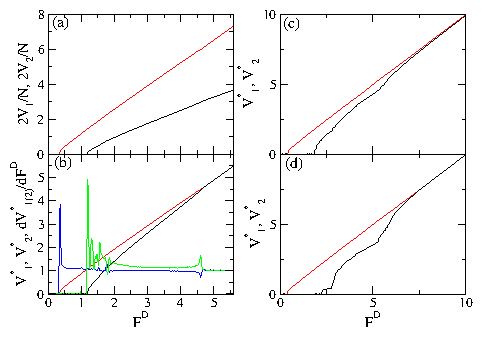
|
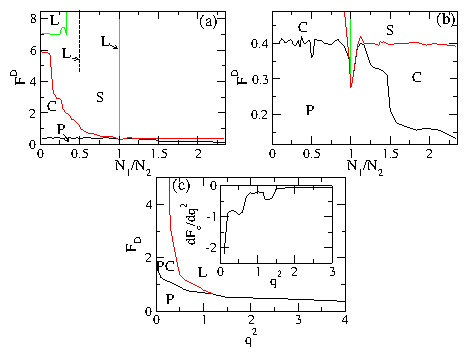
|
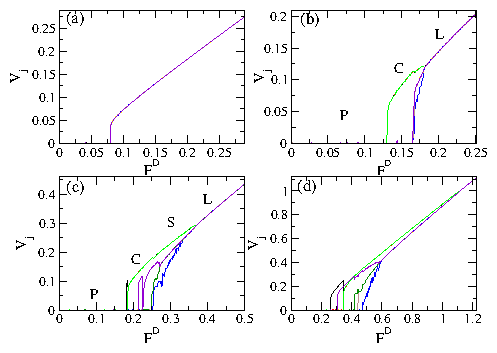
|
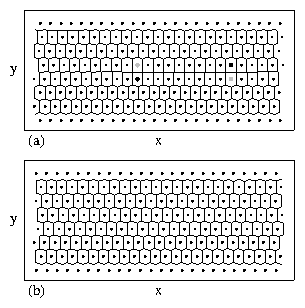
|
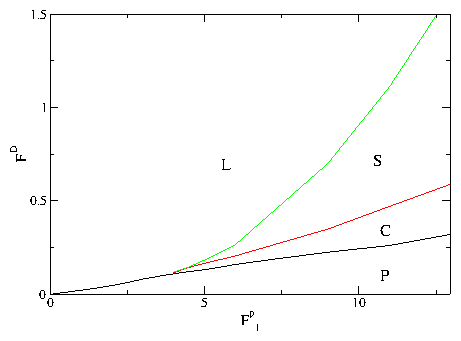
|

|
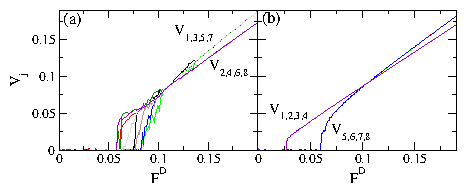
|
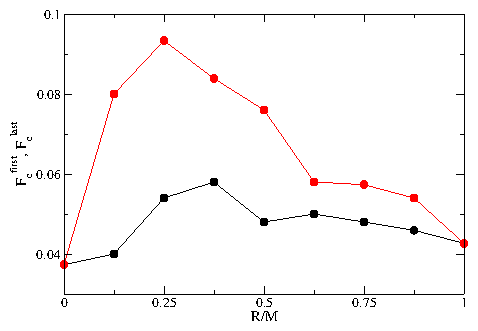
|
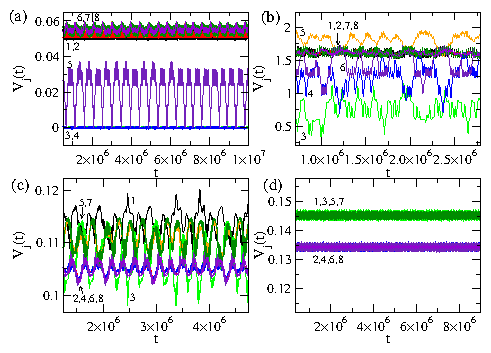
|
VII. DISCUSSION
In our model the particles are strictly confined to 1D channels; however, in many real systems the channels can have a finite width and it is even possible to have a zig-zag pattern form within a single channel when the system becomes dense enough. To explore such issues, the first step would be to consider a single finite width channel and to test whether there is a change in the depinning threshold when the particles change from a 1D line to a buckled or zig-zag state within the channel. One might expect the depinning threshold to increase in the buckled phase since large pileups behind pinned particles are reduced when the particles can move around each other. There is also the question of whether the phases we observe would also occur for coupled 2D layers, where again particles can move around each other and avoid pile-ups. We note that a series of coupled 2D layers resembles layered vortex systems in which elastic-plastic transitions are observed along with a peak effect, suggesting that many of the phases we find can also occur in higher dimensions. Another issue is that fluctuations are generally strongly enhanced in 1D systems, suggesting that in sufficiently large systems, some rare regions containing large fluctuations would produce early decoupling. We found no size effects when we tested systems of different size except for samples considerably smaller than those presented here. Large fluctuations are reduced in our system both because we restrict ourselves to T = 0 and because we consider nonoverlapping pinning sites that are all the same strength within a channel. If we allowed overlapping pinning sites, then in sufficiently large systems we would have rare regions of very strong pinning that would induce a decoupling transition. The same effect would occur if we considered a broad distribution of pinning strengths. For higher dimensional systems, many of the effects we observe could in principle persist for finite temperatures and for pinning that is more random. Another interesting avenue to explore would be periodic or quasiperiodic pinning where additional commensuration effects could occur between the particles and the substrates as well as between particles in adjacent layers.VIII. SUMMARY
We have examined systems of two or multiple one-dimensional channels of coupled particles that interact repulsively within each channel and between the channels. The particles are uniformly driven with an external drive and in the presence of quenched disorder show a series of dynamic phases including a pinned phase, a coexistence between pinned and sliding phases, a sliding phase where the channels move at different average velocities and slip past one another, and a dynamically locked phase where the particle positions in the channels become locked and the channels move at the same velocity. The transitions between these different phases can be observed as clear features in the velocity force curve characteristics. These features include a sudden drop in the velocity or the onset of negative differential conductivity in one of more of the channels at the dynamically induced locking transition. For weak pinning or strong channel coupling, the depinning occurs elastically without any slipping between channels. When the system parameters are varied, such as by decreasing the coupling between channels, we find a transition to plastic depinning, with the initial flow above depinning in the coexistence regime where the channels depin separately. At the transition between elastic and plastic depinning, a peak in the depinning force appears which resembles the peak effect phenomenon found in more complicated models with transitions between elastic and plastic depinning. We have also examined channels containing unequal numbers of pinning sites or particles and find that even for a channel containing no pinning, there can be a finite depinning threshold due to the coupling of the particles in the pin-free channel with the particles in a channel containing pinning. For unequal numbers of particles in the channels we observe commensurability effects where the depinning threshold drops when the depinning becomes elastic for particle number ratios at which the coupling between particles in neighboring channels is enhanced, such as at 1:1 or 2:1. At the incommensurate fillings the channels always depin plastically. For multiple channels we find a hierarchy of dynamically induced coupling phases in which different groups of channels couple, while at higher drive all of the channels become coupled. Despite the apparent simplicity of our model, we find that even the two channel system exhibits many of the prominent features of depinning in more complex models such as the existence of multiple dynamical phases as well as elastic to plastic depinning transitions of the type that have been studied for more complicated systems including 3D layered systems. The specific model studied in this paper could be realized using colloidal particles in coupled 1D channels or in superconductors with a one-dimensional corrugation combined with random pinning where the vortices move along the easy flow direction of the corrugation. Other possible realizations include coupled channels of 1D wires where Wigner crystallization may occur.Acknowledgments
This work was carried out under the auspices of the NNSA of the U.S. DoE at LANL under Contract. No. DE-AC52-06NA25396.References
- [1]
- R.M. Fleming and C.C. Grimes, Phys. Rev. Lett. 42, 1423 (1979); G. Grüner, Rev. Mod. Phys. 60, 1129 (1988); R.E. Thorne, Physics Today 49(5), 42 (1996).
- [2]
- D.S. Fisher, Phys. Rev. B 31, 1396 (1985).
- [3]
- C.R. Myers and J.P. Sethna, Phys. Rev. B 47, 11171 (1993).
- [4]
- H.J. Jensen, A. Brass, Y. Brechet, and A.J. Berlinsky, Phys. Rev. B 38, 9235 (1988); D. Domínguez, Phys. Rev. Lett 72, 3096 (1994); M.C. Faleski, M.C. Marchetti, and A.A. Middleton, Phys. Rev. B 54, 12427 (1996); Q.-H. Chen and X. Hu, Phys. Rev. Lett. 90, 117005 (2003); E. Olive and J.C. Soret, Phys. Rev. Lett. 96, 027002 (2006); N. Mangan, C. Reichhardt, and C.J. Olson Reichhardt, Phys. Rev. Lett. 100, 187002 (2008); P. Moretti and M.-Carmen Miguel, Phys. Rev. B 79, 104505 (2009); Y. Fily, E. Olive, N. Di Scala, and J.C. Soret, Phys. Rev. B 82, 134519 (2010).
- [5]
- S. Bhattacharya and M.J. Higgins, Phys. Rev. Lett. 70, 2617 (1993).
- [6]
- J.A.P Ramos, E. Granato, S.C. Ying, C.V. Achim, K.R. Elder, and T. Ala-Nissila, Phys. Rev. E 81, 011121 (2010).
- [7]
- J. Tekic, O.M. Braun, and B. Hu, Phys. Rev. E 71, 026104 (2005).
- [8]
- Y. Yang, W.-S. Duan, J.-M. Chen, L. Yang, J. Tekic, Z.-G. Shao, and C.-L. Wang, Phys. Rev. E 82, 051119 (2010).
- [9]
- C. Reichhardt and C.J. Olson, Phys. Rev. Lett. 89, 078301 (2002); C. Reichhardt and C.J. Olson Reichhardt, Phys. Rev. E 77, 041401 (2008); C. Reichhardt and C.J. Olson Reichhardt, Phys. Rev. Lett. 103, 168301 (2009).
- [10]
- A. Pertsinidis and X.S. Ling, Phys. Rev. Lett. 100, 028303 (2008).
- [11]
- S.S. Banerjee et al., Phys. Rev. B 58, 995 (1998); W. Henderson, E.Y. Andrei, and M.J. Higgins, Phys. Rev. Lett. 81, 2352 (1998); Z.L. Xiao, E.Y. Andrei, P. Shuk, and M. Greenblatt, Phys. Rev. Lett. 86, 2431 (2001); L. Ammor, A. Ruyter, V.A. Shaidiuk, N.H. Hong, and D. Plessis, Phys. Rev. B 81, 094521 (2010); S. Okuma, Y. Tsugawa, and A. Motohashi, Phys. Rev. B 83, 012503 (2011); I. Guillamón, H. Suderow, S. Vieira, J. Sesé, R. Córdoba, J.M. De Teresa, and M.R. Ibarra, Phys. Rev. Lett. 106, 077001 (2011).
- [12]
- J. Watson and D.S. Fisher, Phys. Rev. B 54, 938 (1996).
- [13]
- A.E. Koshelev and V.M. Vinokur, Phys. Rev. Lett. 73, 3580 (1994).
- [14]
- K. Moon, R.T. Scalettar, and G.T. Zimányi, Phys. Rev. Lett. 77, 2778 (1996); F. Pardo , F. de la Cruz, P.L. Gammel, E. Bucher and D.J. Bishop, Nature (London) 396, 348 (1998); A.B. Kolton, D. Domínguez, and N. Grønbech-Jensen, Phys. Rev. Lett. 83, 3061 (1999).
- [15]
- C.J. Olson, C. Reichhardt, and F. Nori, Phys. Rev. Lett. 81, 3757 (1998).
- [16]
- A. Sengupta, S. Sengupta, and G.I. Menon, Phys. Rev. B 81, 144521 (2010); C.J. Olson Reichhardt, C. Reichhardt, and A.R. Bishop, Phys. Rev. E 83, 041501 (2011).
- [17]
- J. Gutierrez, A.V. Silhanek, J. Van de Vondel, W. Gillijns, and V.V. Moshchalkov, Phys. Rev. B 80, 140514(R) (2009); S. Avci, Z.L. Xiao, J. Hua, A. Imre, R. Divan, J. Pearson, U. Welp, W.K. Kwok, and G.W. Crabtree, Appl. Phys. Lett. 97, 042511 (2010).
- [18]
- P.T. Korda, M.B. Taylor, and D.G. Grier, Phys. Rev. Lett. 89, 128301 (2002); D.G. Grier, Nature (London) 424, 810 (2003); M.P. MacDonald, G.C. Spalding, and K. Dholakia, Nature (London) 426, 421 (2003); K. Xiao and D.G. Grier, Phys. Rev. Lett. 104, 028302 (2010).
- [19]
- A.M. Lacasta, J.M. Sancho, A.H. Romero, and K. Lindenberg, Phys. Rev. Lett 94, 160601 (2005); C. Reichhardt and C.J. Olson Reichhardt, Phys. Rev. E 79, 061403 (2009).
- [20]
- C. Reichhardt, C.J. Olson, and F. Nori, Phys. Rev. Lett. 78, 2648 (1997); C. Reichhardt, G.T. Zimányi, and N Grønbech-Jensen, Phys. Rev. B 64, 014501 (2001); C. Reichhardt and C.J. Olson Reichhardt, Phys. Rev. B 78, 180507(R) (2008).
- [21]
- L. Balents, M.C. Marchetti, and L. Radzihovsky, Phys. Rev. B 57, 7705 (1998); P. Le Doussal and T. Giamarchi, Phys. Rev. B 57, 11356 (1998).
- [22]
- V.M. Vinokur and T. Nattermann, Phys. Rev. Lett. 79, 3471 (1997).
- [23]
- C.J. Olson, G.T. Zimányi, A.B. Kolton, and N. Grønbech-Jensen, Phys. Rev. Lett. 85, 5416 (2000).
- [24]
- C.J. Olson, C. Reichhardt, and V.M. Vinokur, Phys. Rev. B 64, 140502(R) (2001).
- [25]
- R. Besseling, P.H. Kes, T. Dröse, and V.M. Vinokur, New J. Phys. 7, 71 (2005); K. Yu, M.B.S. Hesselberth, P.H. Kes, and B.L.T. Plourde, Phys. Rev. B 81, 184503 (2010).
- [26]
- M.C. Marchetti, A.A. Middleton, K. Saunders, and J.M. Schwarz, Phys. Rev. Lett. 91, 107002 (2003).
- [27]
- P. Le Doussal, M.C. Marchetti, and K.J. Wiese, Phys. Rev. B 78, 224201 (2008).
- [28]
- Z.G. Zhao, Y.X. You, J. Wang, and M. Liu, EPL 82, 47003 (2008).
- [29]
- Q-H. Wei, C. Bechinger, D. Rudhardt, and P. Leiderer, Phys. Rev. Lett. 81, 2606 (1998); J. Baumgartl, M. Brunner, and C. Bechinger, Phys. Rev. Lett. 93, 168301 (2004).
- [30]
- D.V. Tkachenko, V.R. Misko, and F.M. Peeters, Phys. Rev. E 80, 051401 (2009); P. Henseler, A. Erbe, M. Köppl, P. Leiderer, and P. Nielaba, Phys. Rev. E 81, 041402 (2010).
- [31]
- J.C.N. Carvalho, W.P. Ferreira, G.A. Farias, and F.M. Peeters, Phys. Rev. B 83, 094109 (2011).
- [32]
- B. Liu, K. Avinash, and J. Goree, Phys. Rev. Lett. 91, 255003 (2003).
- [33]
- P. Glasson, V. Dotsenko, P. Fozooni, M.J. Lea, W. Bailey, G. Papageorgiou, S.E. Andresen, and A. Kristensen, Phys. Rev. Lett 87, 176802 (2001); H. Ikegami, H. Akimoto, and K. Kono, Phys. Rev. Lett. 102, 046807 (2009); D.G. Rees, I. Kuroda, C.A. Marrache-Kikuchi, M. Höfer, P. Leiderer, and K. Kono, Phys. Rev. Lett. 106, 026803 (2011).
- [34]
- J. Baker and A.G. Rojo, J. Phys. Condens. Matter 13, 5313 (2001).
- [35]
- M. Yamamoto, M. Stopa, Y. Tokura, Y. Hirayama and S. Tarucha, Science 313, 204 (2006); V.M. Deshpande and M. Bockrath, Nature Phys. 4, 314 (2008).
- [36]
- G. Piacente and F.M. Peeters, Phys. Rev. B 72, 205208 (2005).
- [37]
- K. Saunders, J.M. Schwarz, M.C. Marchetti, and A.A. Middleton, Phys. Rev. B 70, 024205 (2004).
- [38]
- C. Bairnsfather, C.J. Olson Reichhardt, and C. Reichhardt, EPL 94, 18001 (2011).
- [39]
- C. Reichhardt, C. Bairnsfather, and C.J. Olson Reichhardt, Phys. Rev. E 83, 061404 (2011).
- [40]
- A. van Otterlo, R.T. Scalettar, and G.T. Zimányi, Phys. Rev. Lett. 81, 1497 (1998); C.J. Olson, C. Reichhardt, R.T. Scalettar, G.T. Zimányi, and N. Grønbech-Jensen, Physica C 384, 143 (2003); H. Fangohr, A.E. Koshelev, and M.J.W. Dodgson, Phys. Rev. B 67, 174508 (2003).
- [41]
- E.R. Nowak, N.E. Israeloff, and A.M. Goldman, Phys. Rev. B 49, 10047 (1994); S. Bhattacharya and M.J. Higgins, Phys. Rev. B 52, 64 (1995); M. Danckwerts, A.R. Goñi, and C. Thomsen, Phys. Rev. B 59, R6624 (1999).
- [42]
- N. Grønbech-Jensen, A.R. Bishop, and D. Domínguez, Phys. Rev. Lett. 76, 2985 (1996).
- [43]
- A.A. Middleton, Phys. Rev. Lett. 68, 670 (1992).
- [44]
- S.S. Banerjee et al., Phys. Rev. B 62, 11838 (2000).
- [45]
- Y.I. Frenkel and T. Kontorowa, Zh. Eksp. Teor. Fiz. 8, 1340 (1938); P. Bak, Rep. Prog. Phys 45, 587 (1982); S.N. Coppersmith, D.S. Fisher, B.I. Halperin, P.A. Lee, and W.F. Brinkman, Phys. Rev. B 25, 349 (1982).
- [46]
- M. Baert, V.V. Metlushko, R. Jonckheere, V.V. Moshchalkov, and Y. Bruynseraede, Phys. Rev. Lett. 74, 3269 (1995); C. Reichhardt, C.J. Olson, and F. Nori, Phys. Rev. B 57, 7937 (1998).
- [47]
- M. Baert, V.V. Metlushko, R. Jonckheere, V.V. Moshchalkov, and Y. Bruynseraede, Europhys. Lett. 29, 157 (1995); C. Reichhardt and N. Grønbech-Jensen, Phys. Rev. B 63, 054510 (2001).
- [48]
- C.J. Olson, C. Reichhardt, and S. Bhattacharya, Phys. Rev. B 64, 024518 (2001).
- [49]
- C. Reichhardt and C.J. Olson Reichhardt, Phys. Rev. E 77, 041401 (2008).
File translated from TEX by TTHgold, version 4.00.
Back to Home